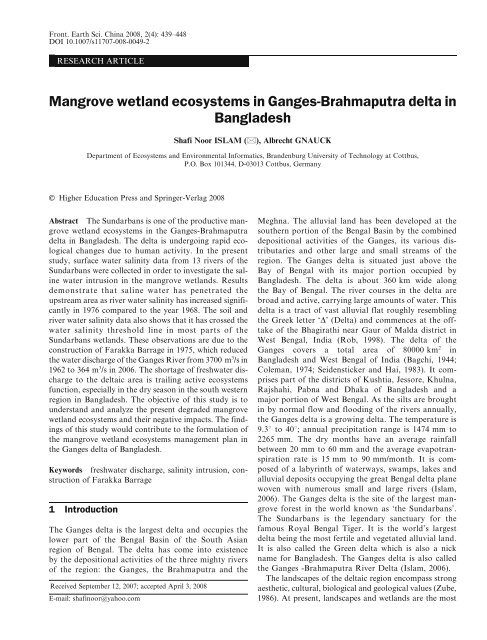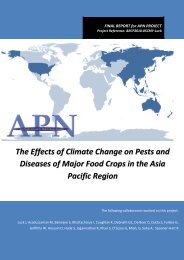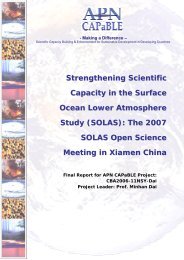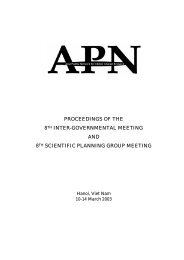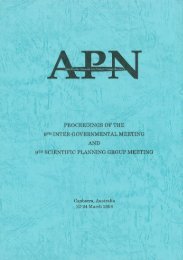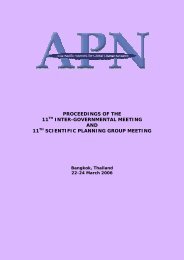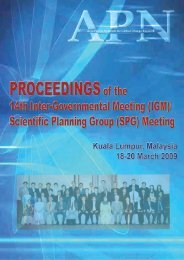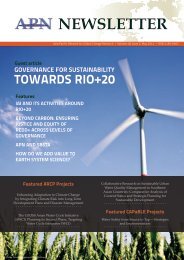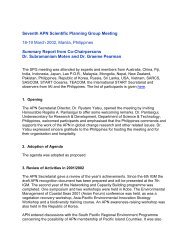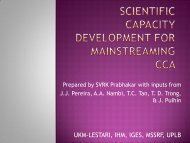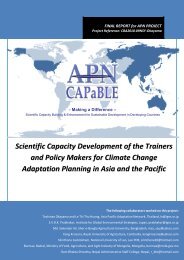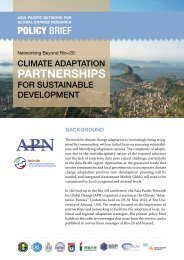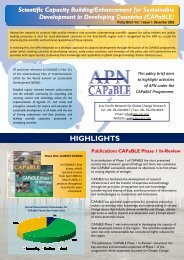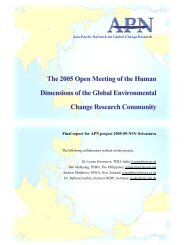Mangrove wetland ecosystems in Ganges-Brahmaputra delta in ...
Mangrove wetland ecosystems in Ganges-Brahmaputra delta in ...
Mangrove wetland ecosystems in Ganges-Brahmaputra delta in ...
Create successful ePaper yourself
Turn your PDF publications into a flip-book with our unique Google optimized e-Paper software.
Front. Earth Sci. Ch<strong>in</strong>a 2008, 2(4): 439–448<br />
DOI 10.1007/s11707-008-0049-2<br />
RESEARCH ARTICLE<br />
<strong>Mangrove</strong> <strong>wetland</strong> <strong>ecosystems</strong> <strong>in</strong> <strong>Ganges</strong>-<strong>Brahmaputra</strong> <strong>delta</strong> <strong>in</strong><br />
Bangladesh<br />
E<br />
Shafi Noor ISLAM (*), Albrecht GNAUCK<br />
Department of Ecosystems and Environmental Informatics, Brandenburg University of Technology at Cottbus,<br />
P.O. Box 101344, D-03013 Cottbus, Germany<br />
Higher Education Press and Spr<strong>in</strong>ger-Verlag 2008<br />
Abstract The Sundarbans is one of the productive mangrove<br />
<strong>wetland</strong> <strong>ecosystems</strong> <strong>in</strong> the <strong>Ganges</strong>-<strong>Brahmaputra</strong><br />
<strong>delta</strong> <strong>in</strong> Bangladesh. The <strong>delta</strong> is undergo<strong>in</strong>g rapid ecological<br />
changes due to human activity. In the present<br />
study, surface water sal<strong>in</strong>ity data from 13 rivers of the<br />
Sundarbans were collected <strong>in</strong> order to <strong>in</strong>vestigate the sal<strong>in</strong>e<br />
water <strong>in</strong>trusion <strong>in</strong> the mangrove <strong>wetland</strong>s. Results<br />
demonstrate that sal<strong>in</strong>e water has penetrated the<br />
upstream area as river water sal<strong>in</strong>ity has <strong>in</strong>creased significantly<br />
<strong>in</strong> 1976 compared to the year 1968. The soil and<br />
river water sal<strong>in</strong>ity data also shows that it has crossed the<br />
water sal<strong>in</strong>ity threshold l<strong>in</strong>e <strong>in</strong> most parts of the<br />
Sundarbans <strong>wetland</strong>s. These observations are due to the<br />
construction of Farakka Barrage <strong>in</strong> 1975, which reduced<br />
the water discharge of the <strong>Ganges</strong> River from 3700 m 3 /s <strong>in</strong><br />
1962 to 364 m 3 /s <strong>in</strong> 2006. The shortage of freshwater discharge<br />
to the <strong>delta</strong>ic area is trail<strong>in</strong>g active <strong>ecosystems</strong><br />
function, especially <strong>in</strong> the dry season <strong>in</strong> the south western<br />
region <strong>in</strong> Bangladesh. The objective of this study is to<br />
understand and analyze the present degraded mangrove<br />
<strong>wetland</strong> <strong>ecosystems</strong> and their negative impacts. The f<strong>in</strong>d<strong>in</strong>gs<br />
of this study would contribute to the formulation of<br />
the mangrove <strong>wetland</strong> <strong>ecosystems</strong> management plan <strong>in</strong><br />
the <strong>Ganges</strong> <strong>delta</strong> of Bangladesh.<br />
Keywords freshwater discharge, sal<strong>in</strong>ity <strong>in</strong>trusion, construction<br />
of Farakka Barrage<br />
1 Introduction<br />
The <strong>Ganges</strong> <strong>delta</strong> is the largest <strong>delta</strong> and occupies the<br />
lower part of the Bengal Bas<strong>in</strong> of the South Asian<br />
region of Bengal. The <strong>delta</strong> has come <strong>in</strong>to existence<br />
by the depositional activities of the three mighty rivers<br />
of the region: the <strong>Ganges</strong>, the <strong>Brahmaputra</strong> and the<br />
Received September 12, 2007; accepted April 3, 2008<br />
E-mail: shaf<strong>in</strong>oor@yahoo.com<br />
Meghna. The alluvial land has been developed at the<br />
southern portion of the Bengal Bas<strong>in</strong> by the comb<strong>in</strong>ed<br />
depositional activities of the <strong>Ganges</strong>, its various distributaries<br />
and other large and small streams of the<br />
region. The <strong>Ganges</strong> <strong>delta</strong> is situated just above the<br />
Bay of Bengal with its major portion occupied by<br />
Bangladesh. The <strong>delta</strong> is about 360 km wide along<br />
the Bay of Bengal. The river courses <strong>in</strong> the <strong>delta</strong> are<br />
broad and active, carry<strong>in</strong>g large amounts of water. This<br />
<strong>delta</strong> is a tract of vast alluvial flat roughly resembl<strong>in</strong>g<br />
the Greek letter ‘D’ (Delta) and commences at the offtake<br />
of the Bhagirathi near Gaur of Malda district <strong>in</strong><br />
West Bengal, India (Rob, 1998). The <strong>delta</strong> of the<br />
<strong>Ganges</strong> covers a total area of 80000 km 2 <strong>in</strong><br />
Bangladesh and West Bengal of India (Bagchi, 1944;<br />
Coleman, 1974; Seidensticker and Hai, 1983). It comprises<br />
part of the districts of Kushtia, Jessore, Khulna,<br />
Rajshahi, Pabna and Dhaka of Bangladesh and a<br />
major portion of West Bengal. As the silts are brought<br />
<strong>in</strong> by normal flow and flood<strong>in</strong>g of the rivers annually,<br />
the <strong>Ganges</strong> <strong>delta</strong> is a grow<strong>in</strong>g <strong>delta</strong>. The temperature is<br />
9.3u to 40u; annual precipitation range is 1474 mm to<br />
2265 mm. The dry months have an average ra<strong>in</strong>fall<br />
between 20 mm to 60 mm and the average evapotranspiration<br />
rate is 15 mm to 90 mm/month. It is composed<br />
of a labyr<strong>in</strong>th of waterways, swamps, lakes and<br />
alluvial deposits occupy<strong>in</strong>g the great Bengal <strong>delta</strong> plane<br />
woven with numerous small and large rivers (Islam,<br />
2006). The <strong>Ganges</strong> <strong>delta</strong> is the site of the largest mangrove<br />
forest <strong>in</strong> the world known as ‘the Sundarbans’.<br />
The Sundarbans is the legendary sanctuary for the<br />
famous Royal Bengal Tiger. It is the world’s largest<br />
<strong>delta</strong> be<strong>in</strong>g the most fertile and vegetated alluvial land.<br />
It is also called the Green <strong>delta</strong> which is also a nick<br />
name for Bangladesh. The <strong>Ganges</strong> <strong>delta</strong> is also called<br />
the <strong>Ganges</strong> -<strong>Brahmaputra</strong> River Delta (Islam, 2006).<br />
The landscapes of the <strong>delta</strong>ic region encompass strong<br />
aesthetic, cultural, biological and geological values (Zube,<br />
1986). At present, landscapes and <strong>wetland</strong>s are the most
440 Shafi Noor ISLAM, Albrecht GNAUCK<br />
spectacular global issues for economic growth and balance<br />
<strong>ecosystems</strong>. On the other hand, water is a fundamental<br />
issue for human survival and their cultural<br />
development. There is an <strong>in</strong>ter-l<strong>in</strong>kage between cultural<br />
landscape development and water availability. Almost<br />
half of the world’s <strong>wetland</strong>s have been destroyed <strong>in</strong> the<br />
past 100 years (Barbier, 1993). The total area of <strong>wetland</strong>s<br />
<strong>in</strong> Bangladesh has been variously estimated as<br />
between 7 and 8 million ha which is almost 50% of<br />
the total land surface. These <strong>in</strong>clude rivers, estuaries,<br />
mangrove swamps, marsh (haors), baor (fresh water<br />
oxbow lake) and bils, water storage reservoirs, fish<br />
ponds and some other lands which are seasonally <strong>in</strong>undated<br />
to a depth of 30 cm or more. In Bangladesh, 45%<br />
of mangrove <strong>wetland</strong>s have already been destroyed due<br />
to shrimp farm<strong>in</strong>g and anthropogenic <strong>in</strong>fluences (Khan<br />
et al., 1994). The area of The <strong>Ganges</strong>-<strong>Brahmaputra</strong>-<br />
Meghna (GBM) dra<strong>in</strong>age bas<strong>in</strong> is 1.76 million km 2 of<br />
which 62% can be found <strong>in</strong> India, 18% <strong>in</strong> Ch<strong>in</strong>a, 7% <strong>in</strong><br />
Nepal and 8% <strong>in</strong> Bangladesh and only 4% <strong>in</strong> Bhutan<br />
(Elahi et al., 1998). The Sundarbans, situated <strong>in</strong> the<br />
<strong>Ganges</strong> <strong>delta</strong>, consists of an area of around 6017 km 2<br />
of which 1400 km 2 of its southern part has been<br />
declared as a natural world heritage site by UNESCO<br />
<strong>in</strong> 1997 (Islam, 2003). The livelihood and ecology of the<br />
<strong>Ganges</strong> <strong>delta</strong> of Bangladesh portion depends on the<br />
<strong>Ganges</strong> fresh water supply (Hasna, 1995).<br />
Approximately 600 000 people are employed seasonally<br />
(UN ESCAP, 1988). The Gorai-Madhumati bas<strong>in</strong><br />
(Figs. 1 and 2(a)) is directly affected by withdrawal of<br />
water from the <strong>Ganges</strong> bas<strong>in</strong>. The goal of this research<br />
is the contribution of a comprehensive management<br />
plan for the susta<strong>in</strong>able conservation and protection<br />
of the Sundarbans mangrove <strong>ecosystems</strong> <strong>in</strong> the<br />
<strong>Ganges</strong> <strong>delta</strong>.<br />
2 Objectives<br />
The objectives of this paper are to understand the nature<br />
of mangrove <strong>wetland</strong>s <strong>ecosystems</strong> <strong>in</strong> the <strong>Ganges</strong> <strong>delta</strong> and<br />
how it is be<strong>in</strong>g changed to cause threats, and to formulate<br />
a long-term management plan for mangrove <strong>wetland</strong>s<br />
resources through the supply of <strong>Ganges</strong> water <strong>in</strong>to<br />
Sundarbans. GIS application would be a proper tool for<br />
mak<strong>in</strong>g decisions and formulat<strong>in</strong>g recommendations for<br />
the protection of Sundarbans <strong>ecosystems</strong>.<br />
3 Geographical location<br />
Most parts of the Bengal Bas<strong>in</strong> and <strong>Ganges</strong> <strong>delta</strong> are<br />
floored with Quaternary sediments eroded from the highlands<br />
on three sides and deposited by the <strong>Ganges</strong>,<br />
<strong>Brahmaputra</strong> and the Meghna Rivers and their tributaries<br />
and distributaries. The <strong>Ganges</strong> River orig<strong>in</strong>ated <strong>in</strong><br />
Gangotri glacier <strong>in</strong> the southern slopes of the Himalayas<br />
and carries discharge from a catchment of about<br />
865000 km 2 <strong>in</strong> India, to Bangladesh (Fig. 1) (Joseph,<br />
2006). The location of the <strong>Ganges</strong>-<strong>Brahmaputra</strong> <strong>delta</strong> is<br />
at latitude of 24u409 N and 88u E longitude. The longitud<strong>in</strong>al<br />
extension of the <strong>delta</strong> is from 88u Eto91u509 E<br />
longitude (Rob, 1998) (Figs. 2(a) and (b)).<br />
The Sundarbans stretches over 10000 km 2 and is<br />
located at the southwest extremity of Bangladesh and<br />
the southeast of the state of West Bengal <strong>in</strong> India. The<br />
Bangladesh part of the Sundarbans is spread over the<br />
districts of Khulna, Bagerhat and Satkhira and the forest<br />
covers about 6017 km 2 (Hussa<strong>in</strong> et al., 1994; Hassan et al,<br />
2001). Almost 62% of the land area lies between latitudes<br />
21u319 N and 22u309 N and between Longitudes 89u189 E<br />
and 90u19 E (Katebi, 2001).<br />
Fig. 1 The <strong>Ganges</strong> <strong>delta</strong> and the Sundarbans location the GBM River catchment
<strong>Mangrove</strong> <strong>wetland</strong> <strong>ecosystems</strong> <strong>in</strong> <strong>Ganges</strong>-<strong>Brahmaputra</strong> <strong>delta</strong> <strong>in</strong> Bangladesh 441<br />
4 The <strong>Ganges</strong> <strong>delta</strong> and the mangrove<br />
<strong>wetland</strong>s<br />
The development of the <strong>Ganges</strong>-<strong>Brahmaputra</strong> <strong>delta</strong> is still<br />
cont<strong>in</strong>u<strong>in</strong>g s<strong>in</strong>ce it began some 125 million years ago<br />
(Ma), after the fragmentation of the Gondwanaland s<strong>in</strong>ce<br />
the early Cretaceous. The <strong>Ganges</strong> <strong>delta</strong>ic pla<strong>in</strong>s are largely<br />
dra<strong>in</strong>ed by <strong>in</strong>numerable distributaries of the <strong>Ganges</strong>. It<br />
has such a gentle slope that ranges from 15 m <strong>in</strong> the north<br />
to nearly one meter <strong>in</strong> the south; and the <strong>in</strong>terfluves have<br />
such a slight relief, the gradient of the <strong>delta</strong> surface is<br />
Fig. 2 (a) The limit and the location of the <strong>Ganges</strong>-<strong>Brahmaputra</strong> <strong>delta</strong><br />
about 0.016 m/km, the rivers criss-cross each other and<br />
have developed a complex river system. The topographic<br />
features are similar to those of the flood pla<strong>in</strong>s except that<br />
the relief is more subdivided. The average elevation of the<br />
<strong>delta</strong> <strong>in</strong> Khulna, Barisal, the Southern part of Faridpur<br />
and the eastern part of Noakhali district is less than 2 m.<br />
The river courses <strong>in</strong> the <strong>delta</strong> are carry<strong>in</strong>g water discharge,<br />
29 692 m 3 /s <strong>in</strong> average <strong>in</strong>to the Bay of Bengal. The discharge<br />
is 80 684 m 3 /s dur<strong>in</strong>g the flood and 6041 m 3 /s dur<strong>in</strong>g<br />
the low water season. The suspended sediment load<br />
dur<strong>in</strong>g the monsoon flood reaches as high as 13 million
442 Shafi Noor ISLAM, Albrecht GNAUCK<br />
Fig. 2(b) The limit of the <strong>Ganges</strong> <strong>delta</strong> and location of <strong>wetland</strong>s<br />
tons per day. The <strong>Ganges</strong> <strong>Brahmaputra</strong> Delta can be<br />
divided <strong>in</strong>to four major categories: i) Moribund <strong>delta</strong>, ii)<br />
Mature <strong>delta</strong> and iii) Active <strong>delta</strong> and iv) Tidally active<br />
<strong>delta</strong> (Fig. 2(a)).<br />
i) The moribund <strong>delta</strong>: The western part of the <strong>delta</strong>ic<br />
pla<strong>in</strong>, bound on the east by Gorai-Madhumati Rivers,<br />
comprises the areas which extend from the northern<br />
boundary of the Khulna district to Jessore and part of<br />
Kushtia district. The area of moribund <strong>delta</strong> covers an<br />
area of about 18000 km 2 . The rivers of the moribund <strong>delta</strong><br />
cannot br<strong>in</strong>g down enough water and silt, even <strong>in</strong> flood<br />
and, be<strong>in</strong>g conf<strong>in</strong>ed with<strong>in</strong> high levees, are not <strong>in</strong> a position<br />
to <strong>in</strong>undate the entire area.<br />
ii) The mature <strong>delta</strong>: The mature <strong>delta</strong> covers an area of<br />
about 31500 km 2 <strong>in</strong> Bangladesh and <strong>in</strong> West Bengal of<br />
India. On average, it <strong>in</strong>cludes Murshidabad (West<br />
Bengal, India), Nadia and 24-Parganas of India and<br />
Meherpur, Kushtia, Chuadanga, Jhenaidaha, Magura,
<strong>Mangrove</strong> <strong>wetland</strong> <strong>ecosystems</strong> <strong>in</strong> <strong>Ganges</strong>-<strong>Brahmaputra</strong> <strong>delta</strong> <strong>in</strong> Bangladesh 443<br />
Jessore, Narial, Khulna, Sathkhira and Bagerhat districts<br />
of Bangladesh.<br />
iii) The active <strong>delta</strong>: The eastern active <strong>delta</strong> covers an<br />
area of about 16500 km 2 . This part of the <strong>Ganges</strong>-<br />
<strong>Brahmaputra</strong> <strong>delta</strong> is about 300 km long <strong>in</strong> the northsouth<br />
direction and about 100 km and 130 km wide <strong>in</strong><br />
the upper and middle reaches, respectively. The eastern<br />
active <strong>Ganges</strong>-<strong>Brahmaputra</strong> <strong>delta</strong> <strong>in</strong>cludes Rajbari,<br />
Faridpur, Shariatpur, and Madaripur, Gopalgonj,<br />
Lakshmipur, Pirojpur, Barisal, Jhalokati, Patuakhali,<br />
Barguna and Bhola districts of the country.<br />
iv) The tidally active <strong>delta</strong>: The southwestern part of the<br />
<strong>Ganges</strong> <strong>delta</strong> is coastal area and a tidally active <strong>delta</strong>. It is<br />
dom<strong>in</strong>ated by coastal tidal currents. The tidally active <strong>delta</strong><br />
actually is the southern part of the Sundarbans region. It<br />
covers an area of about 13500 km 2 . The Tidally active <strong>delta</strong><br />
<strong>in</strong>cludes the southern part of Bagerhat, Khulna, Sathkhira<br />
district of Bangladesh and south 24 Pargona district of<br />
West Bengal <strong>in</strong> India (Islam, 2006).<br />
The surface water flow <strong>in</strong> the rivers of the<br />
Sundarbans area ma<strong>in</strong>ly comes from the <strong>Ganges</strong> at<br />
the off-take of Gorai-Madhumati and from the lower<br />
Meghna through Swarupkati Kocha River (Figs. 2(a)<br />
and 3). Sal<strong>in</strong>ity content of rivers <strong>in</strong> the Sundarbans<br />
shows a special variability. The water sal<strong>in</strong>ity pattern<br />
shows both seasonal and spatial variation. Dur<strong>in</strong>g pre-<br />
Fig. 3 Three ecological zones <strong>in</strong> the Sundarbans region<br />
monsoon (March–April), the conductivity of river<br />
water is high and ranges from 7 mS/cm to 52 mS/cm.<br />
In the post monsoon season (Aug-Sept), the conductivity<br />
of river water decreases (0–21.5 mS/cm). Water<br />
sal<strong>in</strong>ity level <strong>in</strong> the rivers of the eastern region both<br />
<strong>in</strong> pre-monsoon and post-monsoon season is low (0–<br />
7 mS/cm) <strong>in</strong> comparison to western rivers.<br />
5 Data and Methodology<br />
The present study was conducted based on primary and<br />
secondary data sources. The sal<strong>in</strong>e water and soil samples<br />
were collected and tested at the laboratory for <strong>in</strong>vestigation<br />
of water sal<strong>in</strong>ity <strong>in</strong>trusion trends. The survey covers<br />
Munchiganj, Mirgang, Koira, Kasiabad, Mongla,<br />
Kathka, Kochikhali, Hironpo<strong>in</strong>t, Malancha-Mundarbaria,<br />
and Burigoal<strong>in</strong>i (Fig. 3). Primary data on surface<br />
water sal<strong>in</strong>ity was obta<strong>in</strong>ed from 13 rivers <strong>in</strong>clud<strong>in</strong>g Sibsa<br />
River, Passur River, Chunnar River, Kholpetua River,<br />
Bal Jhalia River, Baleswar River, Betmargang River,<br />
Notabaki River, Passakhali River, Arpongasia River,<br />
Kathka River, Nilkamol River, and Malancha River<br />
(Fig. 4) of the Sundarbans by the Institute of Water<br />
Modell<strong>in</strong>g (IWM). The survey was done <strong>in</strong> different ecologically<br />
sensitive areas between February-July <strong>in</strong> 2003.
444 Shafi Noor ISLAM, Albrecht GNAUCK<br />
The data was processed and analyzed through MS Excel,<br />
GISArcView 9.1 for data visualization and MATLAB<br />
software version 7.1 were used for simulation.<br />
6 Results and discussion<br />
To understand the real situation <strong>in</strong> the Sundarbans<br />
region, 13 important rivers (Fig. 5) located around<br />
the case area have been chosen for modell<strong>in</strong>g of their<br />
water sal<strong>in</strong>ity. The time series data of water sal<strong>in</strong>ity has<br />
been collected from 13 river bas<strong>in</strong>s (Fig. 5) <strong>in</strong> the<br />
Sundarbans mangrove <strong>wetland</strong>s area based on the<br />
potentiality of the river bas<strong>in</strong>s and <strong>ecosystems</strong> balance.<br />
All 13 rivers show <strong>in</strong>creas<strong>in</strong>g water sal<strong>in</strong>ity. The results<br />
of the <strong>in</strong>vestigation of water sal<strong>in</strong>ity show that the<br />
sal<strong>in</strong>ity rate is much higher <strong>in</strong> the southern and<br />
south-western rivers; the rivers of the middle area are<br />
moderate level and the rivers of the northern portion<br />
carries low sal<strong>in</strong>ity than the rivers of middle area of the<br />
Sundarbans (Figs. 4 and 5).<br />
The river water sal<strong>in</strong>ity trends show that only one river<br />
has crossed the threshold l<strong>in</strong>e (43220 dS/m) (Colugh,<br />
1985) <strong>in</strong> 2000; six rivers have crossed the threshold l<strong>in</strong>e<br />
<strong>in</strong> 2001; eight rivers have crossed the threshold l<strong>in</strong>e <strong>in</strong><br />
2002; and eleven rivers have crossed the threshold l<strong>in</strong>e <strong>in</strong><br />
Fig. 4 The <strong>in</strong>creas<strong>in</strong>g sal<strong>in</strong>ity trends <strong>in</strong> the Sundarbans<br />
2003 (Fig. 4). Therefore, the results show that the river<br />
water sal<strong>in</strong>ity trends are gradually <strong>in</strong>creas<strong>in</strong>g and more<br />
rivers are affected by NaCl <strong>in</strong> the Sundarbans <strong>in</strong><br />
Bangladesh.<br />
The high sal<strong>in</strong>ity zone is located <strong>in</strong> the south-western<br />
corner of the Sundarbans, where the previous sal<strong>in</strong>ity<br />
values were 38 898 dS/m to 54025 dS/m, whereas the present<br />
values are 54025 dS/m to 69152 dS/m. The high sal<strong>in</strong>e<br />
affected area extends from south to north and east to<br />
west direction, which is poses an extremely high threat for<br />
mangrove <strong>wetland</strong> <strong>ecosystems</strong> <strong>in</strong> the Sundarbans. The<br />
results of water sal<strong>in</strong>ity simulation of the Sundarbans<br />
Rivers will support the formulation of a plan by decision<br />
makers to protect the special natural heritage site and<br />
mangrove <strong>wetland</strong>s <strong>ecosystems</strong> <strong>in</strong> the Sundarbans region<br />
<strong>in</strong> Bangladesh (Fig. 4).<br />
6.1 Water allocation <strong>in</strong> the <strong>Ganges</strong> bas<strong>in</strong><br />
The <strong>Ganges</strong> River rises at an elevation of 7667 meters <strong>in</strong><br />
Gangotri glacier of Kashi district of India on the southern<br />
slopes of the Himalayan range. The length of the<br />
river <strong>in</strong> Bangladesh is about 2550 km and covers an area<br />
of about 46300 km 2 . It stretches for more than 1600 km 2<br />
between Tibet <strong>in</strong> Ch<strong>in</strong>a and India. The three major tributaries,<br />
Gandok, Ghagra and Kosi pass through the
<strong>Mangrove</strong> <strong>wetland</strong> <strong>ecosystems</strong> <strong>in</strong> <strong>Ganges</strong>-<strong>Brahmaputra</strong> <strong>delta</strong> <strong>in</strong> Bangladesh 445<br />
Fig. 5 Water sal<strong>in</strong>ity isohal<strong>in</strong>e <strong>in</strong> the Sundarbans region (Base Map: Islam, 2006)<br />
territory of Nepal. The Yamuna jo<strong>in</strong>s the <strong>Ganges</strong> below<br />
Alahabad after receiv<strong>in</strong>g the Chambal, H<strong>in</strong>don, S<strong>in</strong>dh,<br />
Betwa and Ken. The <strong>Ganges</strong> enters Bangladesh about<br />
17 km down the Farakka Dam. The Gorai is the ma<strong>in</strong><br />
tributary of the <strong>Ganges</strong> which enters the Sundarbans<br />
and supplies upstream fresh water and jo<strong>in</strong>s Baleswar<br />
River (Figs. 3 and 5) downstream. The confluence<br />
receives the Meghna a few kilometers downstream<br />
before it merges <strong>in</strong>to the Bay of Bengal (Begum, 1987).<br />
The construction of the Barrage is 2455 m long and is<br />
designed for maximum discharge of 75630 m 3 /s. In 1972<br />
the Government of Bangladesh took up the <strong>Ganges</strong><br />
issue <strong>in</strong> earnest to the Government of India. The same<br />
year the Indo-Bangladesh Jo<strong>in</strong>t River Commission<br />
(JRC) was constituted <strong>in</strong> 1972. After a collaborative<br />
discussion at the summit <strong>in</strong> 1974, it was agreed between<br />
Bangladesh and India that Farakka Barrage would not<br />
be <strong>in</strong> operation before an agreement was reached on<br />
shar<strong>in</strong>g the dry season flow of the <strong>Ganges</strong> between the<br />
two countries (Miah, 2003).<br />
6.2 Reduced <strong>Ganges</strong> water and <strong>in</strong>creased sal<strong>in</strong>ity<br />
Bangladesh receives low quantity of water discharge after<br />
the construction of the Farakka Barrage on the <strong>Ganges</strong><br />
River <strong>in</strong> India due to water withdrawal at Farakka<br />
Barrage po<strong>in</strong>t downstream for irrigation purposes <strong>in</strong> the<br />
lean season. There was a comparison of sal<strong>in</strong>ity <strong>in</strong>trusion<br />
<strong>in</strong> 1967–1968 with the situation which occurred dur<strong>in</strong>g<br />
1976 and 1977 because the unimpaired dry season flows<br />
of these years were comparable. The water sal<strong>in</strong>ity<br />
approximations before and after 1975 <strong>in</strong> the Sundarbans<br />
region are shown <strong>in</strong> Fig. 6, which shows the water sal<strong>in</strong>ity<br />
approximations before and after 1975 <strong>in</strong> the Sundarbans<br />
region. A comparative survey analysis was done <strong>in</strong> 2003<br />
based on data of 1968, 1970 and 1976. The result shows<br />
that, the river water sal<strong>in</strong>ity has <strong>in</strong>creased significantly <strong>in</strong><br />
1976 compared to that <strong>in</strong> 1968 (Fig. 6).<br />
The amount of the <strong>Ganges</strong> river water flow <strong>in</strong><br />
Bangladesh is <strong>in</strong>fluenced by the effect of the amount of<br />
water drawn at the Farakka Barrage by India. The
446 Shafi Noor ISLAM, Albrecht GNAUCK<br />
Fig. 6 Water sal<strong>in</strong>ity after and before Farakka barrage construction <strong>in</strong> 1975 <strong>in</strong> India<br />
<strong>Ganges</strong> flow was 3700 m 3 /s <strong>in</strong> 1962 whereas it was reduced<br />
to 364 m 3 /s <strong>in</strong> 2006 (Nishat, 2006) (Fig. 7). As a result, the<br />
high sal<strong>in</strong>e sea water has penetrated <strong>in</strong> the upstream, and<br />
fall<strong>in</strong>g water tables occurred. Fig. 7 shows a strong correlation<br />
between <strong>Ganges</strong> water discharge reduction and<br />
sal<strong>in</strong>ity <strong>in</strong>trusion. The reduced water flow l<strong>in</strong>e and<br />
<strong>in</strong>creased sal<strong>in</strong>ity l<strong>in</strong>e has crossed at a certa<strong>in</strong> po<strong>in</strong>t <strong>in</strong><br />
1975 (optimum po<strong>in</strong>t).<br />
At this cross po<strong>in</strong>t the <strong>Ganges</strong> water flow was almost<br />
1500 m 3 /s. This water level l<strong>in</strong>e can be <strong>in</strong>troduced as the<br />
optimal l<strong>in</strong>e where both l<strong>in</strong>es crossed at the particular<br />
po<strong>in</strong>t and this po<strong>in</strong>t can be called as the optimum po<strong>in</strong>t<br />
of sal<strong>in</strong>ity <strong>in</strong>trusion. The isohal<strong>in</strong>e sal<strong>in</strong>ity map (Fig. 5)<br />
shows the real scenario of sal<strong>in</strong>ity <strong>in</strong>trusion <strong>in</strong> the<br />
Sundarbans.<br />
To compare the <strong>in</strong>creas<strong>in</strong>g sal<strong>in</strong>ity trends of three ecological<br />
zones, the present situation is much more harmful<br />
than that of 30 years before. Consider<strong>in</strong>g the value of water<br />
sal<strong>in</strong>ity, the eastern zone still has a suitable condition for<br />
mangrove <strong>ecosystems</strong>; the middle area is rapidly turn<strong>in</strong>g<br />
from middle sal<strong>in</strong>e zone to high sal<strong>in</strong>e zone; and the southwestern<br />
region which carries the highest rate of water sal<strong>in</strong>ity<br />
would be more harmful for sensitive mangroves plants<br />
and animals <strong>in</strong> the Sundarbans (Fig. 4).<br />
6.3 Increased sal<strong>in</strong>ity and degraded <strong>ecosystems</strong> <strong>in</strong> the<br />
Sundarbans<br />
The reduction of <strong>Ganges</strong> fresh water <strong>in</strong> the upstream area is<br />
the ma<strong>in</strong> reason for sal<strong>in</strong>ity <strong>in</strong>trusion <strong>in</strong> the southwestern<br />
Fig. 7 <strong>Ganges</strong> water flow decreased and sal<strong>in</strong>ity <strong>in</strong>creased at Passur-Mongla po<strong>in</strong>t
<strong>Mangrove</strong> <strong>wetland</strong> <strong>ecosystems</strong> <strong>in</strong> <strong>Ganges</strong>-<strong>Brahmaputra</strong> <strong>delta</strong> <strong>in</strong> Bangladesh 447<br />
part of Bangladesh. Therefore, the <strong>in</strong>creased sal<strong>in</strong>ity and<br />
alkal<strong>in</strong>ity has damaged vegetation, agricultural cropp<strong>in</strong>g<br />
pattern and changed the cultural landscapes <strong>in</strong> the<br />
Sundarbans region. The impact on soil starts with the<br />
destruction of surface organic matter and soil fertility for<br />
mangrove plants production. The changes altered basic soil<br />
characteristics related to aeration, temperature, moisture<br />
and the organisms that live <strong>in</strong> the soil. The core elements<br />
of the ecosystem such as soil, water, vegetation and wildlife<br />
are strongly affected due to fresh water shortage and human<br />
activity. The results of the study of EGIS (Environmental<br />
Geographical Information Studies) shows that water quality<br />
has degraded dur<strong>in</strong>g the dry season (February-June) <strong>in</strong><br />
the Sundarbans rivers where 60% wateris<strong>in</strong>poorquality<br />
with EC dS/m be<strong>in</strong>g 5532.16 and 40% is <strong>in</strong> good quality<br />
with EC dS/m be<strong>in</strong>g 2766.08 (EGIS, 2000).<br />
6.4 Loss of biodiversity and threats for coastal food<br />
security<br />
The scarcity of the <strong>Ganges</strong> flow is a challenge for coastal<br />
food security, mangrove <strong>wetland</strong> <strong>ecosystems</strong> protection,<br />
and further improvement of coastal sal<strong>in</strong>e environment.<br />
The research f<strong>in</strong>d<strong>in</strong>g has asserted that India’s diversion of<br />
water had resulted <strong>in</strong> a loss of rice output of 236000 metric<br />
tons <strong>in</strong> 1976. Deforestation of mangroves due to shrimp<br />
farm<strong>in</strong>g, salt farm<strong>in</strong>g and agriculture adversely affects mar<strong>in</strong>e<br />
fish production and leads to a loss of biodiversity and of<br />
livelihood to over 6 million people who depended on mangroves<br />
(Anon, 1995). A number of species like Javan rh<strong>in</strong>oceros<br />
(Rh<strong>in</strong>oceros sondaicus), water buffalo (Bubalus<br />
bubalis), swamp deer (Cervus duvauceli), Guar (Bos gaurus),<br />
hog deer (Axix porc<strong>in</strong>us) and marsh crocodile (Crocodiles<br />
palustric) became ext<strong>in</strong>ct dur<strong>in</strong>g the last 100 years <strong>in</strong> the<br />
Sundarbans. Oil spill is another potential threat and could<br />
cause immense damage, especially to aquatic fauna and<br />
seabirds and probably also to the mangrove forest biodiversity<br />
(Blower, 1985). The yearly natural calamity, global<br />
warm<strong>in</strong>g and its impacts are new challeng<strong>in</strong>g threats for<br />
coastal food security and biodiversity (Husa<strong>in</strong>, 1995).<br />
6.5 Top dy<strong>in</strong>g diseases<br />
With the commission<strong>in</strong>g of the Farakka Barrage, the discharge<br />
<strong>in</strong> the downstream was drastically reduced. As a<br />
result, all the elements of <strong>ecosystems</strong> development on the<br />
availability of water were affected. The siltation <strong>in</strong> the<br />
Sundarbans has <strong>in</strong>creased and sediment trapp<strong>in</strong>g has been<br />
aided by pneumatophores and dense roots of mangroves.<br />
The dom<strong>in</strong>ant species of sundari (Heritiera fomes) and<br />
Goran (Cariops decandra) are affected by top-dy<strong>in</strong>g disease.<br />
Almost 265 km 2 areas of Heritiera type forest are<br />
moderately affected and 210 km 2 areas are severely affected,<br />
which is one of the ma<strong>in</strong> threats for a susta<strong>in</strong>able<br />
mangrove <strong>wetland</strong> management and the protection of its<br />
<strong>ecosystems</strong>.<br />
7 Conclusions<br />
The Sundarbans mangrove <strong>wetland</strong>s, Chandabill-Baghiar<br />
bill, Bildakatia, Atadanga Baor (Fresh water oxbow lake),<br />
and Marijat Baor (Fig. 2(b)) are situated <strong>in</strong> the <strong>Ganges</strong><br />
<strong>delta</strong>. The <strong>Ganges</strong> fresh water plays an important role <strong>in</strong><br />
protect<strong>in</strong>g these <strong>wetland</strong>s and its <strong>ecosystems</strong> <strong>in</strong> the <strong>delta</strong>.<br />
Consider<strong>in</strong>g the <strong>in</strong>creas<strong>in</strong>g sal<strong>in</strong>ity trends <strong>in</strong> the region,<br />
the threshold values of water sal<strong>in</strong>ity for the Sundarbans<br />
case has been analyzed. In this study, 13 potential river<br />
bas<strong>in</strong>s were <strong>in</strong>vestigated and it has been asserted that 11<br />
rivers have crossed the water sal<strong>in</strong>ity threshold l<strong>in</strong>e<br />
(43220 dS/m) <strong>in</strong> 2003. The previous average water sal<strong>in</strong>ity<br />
value was 54025 dS/m, whereas the present highest water<br />
sal<strong>in</strong>ity value is 69152 dS/m which is harmful and poses<br />
threats to mangrove <strong>wetland</strong> <strong>ecosystems</strong>. The sal<strong>in</strong>e affected<br />
areas extend from south to north and east to west<br />
direction and the iso-hal<strong>in</strong>e map is gradually chang<strong>in</strong>g<br />
because of <strong>in</strong>creas<strong>in</strong>g sal<strong>in</strong>ity trends (Figs. 4 and 5). The<br />
<strong>Ganges</strong> water availability <strong>in</strong> the bas<strong>in</strong> and water sal<strong>in</strong>ity<br />
trends of the downstream show the cyclic <strong>in</strong>creas<strong>in</strong>g behavior<br />
<strong>in</strong> the Sundarbans Rivers. It clearly <strong>in</strong>dicates and<br />
forecasts the message that the upstream freshwater supply<br />
is necessary for the protection of the mangrove <strong>wetland</strong><br />
<strong>ecosystems</strong> <strong>in</strong> the Sundarbans region. It has been <strong>in</strong>dicated<br />
that there is a strong relationship between freshwater<br />
supply and the quality of water <strong>in</strong> the Sundarbans<br />
and water quality and <strong>ecosystems</strong> management are more<br />
closely related. The <strong>Ganges</strong> water flow l<strong>in</strong>e and sal<strong>in</strong>ity<br />
<strong>in</strong>creas<strong>in</strong>g l<strong>in</strong>e crossed at a certa<strong>in</strong> po<strong>in</strong>t (Fig. 7), which is<br />
recognized as optimal po<strong>in</strong>t and optimal l<strong>in</strong>e. In conclusion,<br />
it can be said that if the water level does not cross the<br />
optimal l<strong>in</strong>e then there will be no problem for the mangrove<br />
<strong>ecosystems</strong>. This is why the <strong>Ganges</strong> freshwater supply<br />
<strong>in</strong> the <strong>Ganges</strong> <strong>delta</strong> <strong>in</strong> Bangladesh is necessary for the<br />
protection of coastal resources and mangrove <strong>wetland</strong><br />
<strong>ecosystems</strong>. The f<strong>in</strong>d<strong>in</strong>gs of this study would be a potential<br />
contribution <strong>in</strong> formulat<strong>in</strong>g a comprehensive <strong>in</strong>terdiscipl<strong>in</strong>ary<br />
management plan for the long-term<br />
conservation and protection of mangrove <strong>wetland</strong> <strong>ecosystems</strong><br />
<strong>in</strong> the Sundarbans region <strong>in</strong> the <strong>Ganges</strong> Delta <strong>in</strong><br />
Bangladesh.<br />
Acknowlegements The authors would like to thank different persons<br />
met at Sundarbans Biodiversity Conservation Project and the<br />
Department of Environment and Forest, Bangladesh. The f<strong>in</strong>ancial support<br />
for this study was partly provided by APN Mega Delta Project. We<br />
acknowledge APN Mega Delta Project and give special thanks to Dr.<br />
Zhongyuan Chen of APN Mega Delta Project Leader and Professor of<br />
East Ch<strong>in</strong>a Normal University, Shanghai, Ch<strong>in</strong>a.<br />
References<br />
Anon (1995). Integrated resource management plan of the<br />
Sundarbans reserved forest vol 1. Draft f<strong>in</strong>al report of FAO/<br />
UNDP project BGD/84/056–<strong>in</strong>tegrated resource development<br />
of the Sundarbans resource forest, Khulna, Bangladesh, 385
448 Shafi Noor ISLAM, Albrecht GNAUCK<br />
Bagchi K G (1944). The <strong>Ganges</strong> Delta. Calcutta: Calcutta<br />
University Press, 1–25<br />
Barbier E B (1993). Susta<strong>in</strong>able use of <strong>wetland</strong>s valu<strong>in</strong>g tropical<br />
<strong>wetland</strong> benefits: Economic methodologies and applications.<br />
The Geographical Journal, 159(1): 2–52<br />
Begum K (1987). Tention Over the Farakka Barrage _a Techno<br />
Political Tangle <strong>in</strong> South Asia. Dhaka: University Press Limited, 279<br />
Blower J (1985). Sundarbans forest <strong>in</strong>ventory project, Bangladesh.<br />
Wildlife conservation <strong>in</strong> the Sundarbans. Project report 151.<br />
Overseas Development Adm<strong>in</strong>istration, Land Resources<br />
Development Centre, Surbition, UK, 39<br />
Coleman J M (1974). Deltaic Evolution, the Encyclopedia of<br />
Geomorphology. In: Fairbridge R W (ed.,), New York, USA,<br />
252–255<br />
Colugh B F (1985). Factors Regulat<strong>in</strong>g <strong>Mangrove</strong> Ecosystem<br />
Primary Productivity. Proceed<strong>in</strong>gs of the UNDP/UNESCO<br />
Regional Project RAS/79/002 Workshop on <strong>Mangrove</strong><br />
Ecosystem Dynamics, Papua New Gu<strong>in</strong>ea. 79–85<br />
EGIS–Environmental and Geographical Information Studies<br />
(2000). Bangladesh Water Development Board-Environmental<br />
basel<strong>in</strong>e of Gorai River restoration project. (EGIS-I, EGIS-II,<br />
and EGIS-III). Environment and GIS support project for water<br />
sector plann<strong>in</strong>g, M<strong>in</strong>istry of Water Resources, Government of the<br />
Peoples Republic of Bangladesh, EGIS, Dhaka, 190<br />
Elahi K M, Das S C, Sultana S, et al (1998). Geography of Coastal<br />
Environment: a Study of Selected Issues. In: Bayes A,<br />
Mahammad A, Bangladesh at 25, an analytical discourse on<br />
development. Dhaka: The University Press Limited, 336–368<br />
Hasna J M, (1995). Women for Water Shar<strong>in</strong>g. Dhaka: Academic<br />
Publishers, 1–136<br />
Hassan M, Rahman M S, Haider Z M, et al (2001). Some Facts and<br />
Observations Related to Sal<strong>in</strong>ity and the River System of the<br />
Sundarbans <strong>Mangrove</strong> Forest. Paper presented at 1st national<br />
conference on the Sundarbans at Khulna University. 14-16<br />
February, Khulna. Bangladesh, 1– 4<br />
Husa<strong>in</strong> K Z (1995). The Farakka Catastrophe Reflectiona. In:<br />
Hasna J M, (ed.,) Women for Water Shar<strong>in</strong>g. Dhaka:<br />
Academic Publishers, 71–72<br />
Hussa<strong>in</strong> Z, Acharya G (1994). <strong>Mangrove</strong> of the Sundarbans, Vol<br />
2, Bangladesh. IUCN–Bangkok. Thailand: Dyna Pr<strong>in</strong>t Ltd, 1–<br />
209<br />
Islam S N (2003). Susta<strong>in</strong>able Eco-tourism as a Practical<br />
Management Policy. Dhaka: AH Development Publish<strong>in</strong>g<br />
House, 34–47<br />
Islam S (ed.,) (2006). Banglapedia: <strong>Ganges</strong>-Padma River System,<br />
National Encyclopaedia of Bangladesh, Asiatic Society of<br />
Bangladesh. Asiatic civil Military Press, Dhaka. http://www.<br />
banglapedia.org/English/Index.htm<br />
Joseph P S (2006). The Environmental Management Do Better<br />
Supply of Fresh Water <strong>in</strong> Transboundary River: The <strong>Ganges</strong><br />
Could Run Dry. In: Perez J G (ed.,). Proceed<strong>in</strong>gs of III<br />
International Symposium on Transboundary Water<br />
Management–Overcom<strong>in</strong>g Water Management Boundaries.<br />
Ciudad Real: Universidad de Castilla-La Mancha, 1–101<br />
Katebi M N A (2001). Sundarbans and Forestry. In: Haider (ed.,).<br />
Cyclone’91–An Environmental and Perceptional Study. Dhaka:<br />
BACS, Dhaka, 79–100<br />
Khan S M, Haq E, Huq S, et al (1994). Wetlands of Bangladesh.<br />
Bangladesh Centre for Advanced Studies (BCAS). Dhaka:<br />
Holiday Pr<strong>in</strong>ters Limited, 2–57<br />
Miah M (2003). Hydro-politics of the Farakka Barrage. http://www.<br />
sdnpbd.org/river-bas<strong>in</strong>/bangla<br />
Nishat A (2006). Water at Farakka Barrage <strong>in</strong> 2006. http://www.<br />
ajkerkagoj.com/2006/April 08/Dhaka<br />
Rob M A (1998). Chang<strong>in</strong>g morphology of the coastal region of<br />
<strong>Ganges</strong> Delta. Oriental Geographer, 41(2), 1997. Dhaka:<br />
Dhaka University, 49–64<br />
Seidensticker J, Hai M A (1983). The Sundarbans Wildlife<br />
Management Plan, Conservation <strong>in</strong> the Bangladesh Coastal<br />
Zone. IUCN, Gland, Switzerland, 1–20<br />
UN ESCAP-United Nations/Economic and Social Cooperation for<br />
Asia and the Pacific (1988). Coastal environmental management<br />
plan for Bangladesh. UNESCAP, Bangkok, Thailand, 2–25<br />
Zube E H (1986). Landscape values: History, Concepts and<br />
Applications. In: Smardon P, and Felleman (eds.,).<br />
Foundations for visual project analysis. New York: John Wilay<br />
& Sons, USA, 4–19


